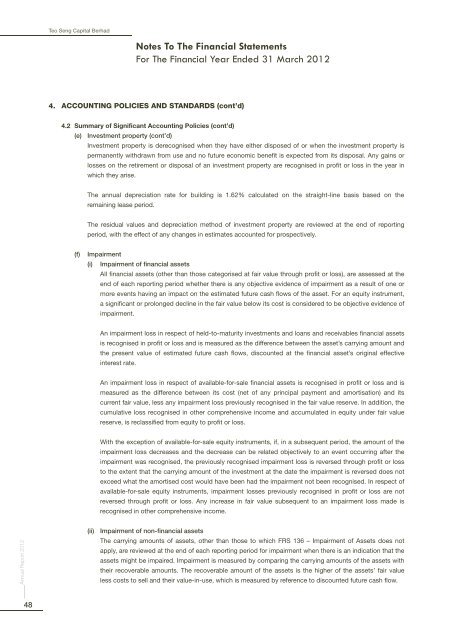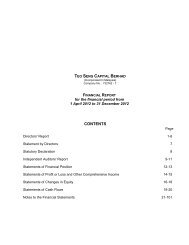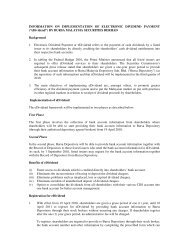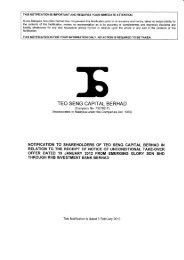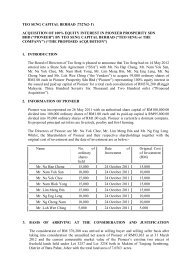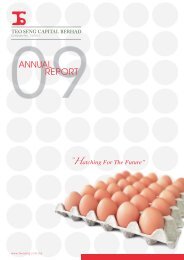Hatching For The Future - teo seng capital berhad
Hatching For The Future - teo seng capital berhad
Hatching For The Future - teo seng capital berhad
Create successful ePaper yourself
Turn your PDF publications into a flip-book with our unique Google optimized e-Paper software.
Teo Seng Capital Berhad<br />
Notes To <strong>The</strong> Financial Statements<br />
<strong>For</strong> <strong>The</strong> Financial Year Ended 31 March 2012<br />
4.<br />
ACCOUNTING POLICIES AND STANDARDS (cont’d)<br />
4.2<br />
Summary of Significant Accounting Policies (cont’d)<br />
(e) Investment property (cont’d)<br />
Investment property is derecognised when they have either disposed of or when the investment property is<br />
permanently withdrawn from use and no future economic benefit is expected from its disposal. Any gains or<br />
losses on the retirement or disposal of an investment property are recognised in profit or loss in the year in<br />
which they arise.<br />
<strong>The</strong> annual depreciation rate for building is 1.62% calculated on the straight-line basis based on the<br />
remaining lease period.<br />
<strong>The</strong> residual values and depreciation method of investment property are reviewed at the end of reporting<br />
period, with the effect of any changes in estimates accounted for prospectively.<br />
(f)<br />
Impairment<br />
(i) Impairment of financial assets<br />
All financial assets (other than those categorised at fair value through profit or loss), are assessed at the<br />
end of each reporting period whether there is any objective evidence of impairment as a result of one or<br />
more events having an impact on the estimated future cash flows of the asset. <strong>For</strong> an equity instrument,<br />
a significant or prolonged decline in the fair value below its cost is considered to be objective evidence of<br />
impairment.<br />
An impairment loss in respect of held-to-maturity investments and loans and receivables financial assets<br />
is recognised in profit or loss and is measured as the difference between the asset’s carrying amount and<br />
the present value of estimated future cash flows, discounted at the financial asset’s original effective<br />
interest rate.<br />
An impairment loss in respect of available-for-sale financial assets is recognised in profit or loss and is<br />
measured as the difference between its cost (net of any principal payment and amortisation) and its<br />
current fair value, less any impairment loss previously recognised in the fair value reserve. In addition, the<br />
cumulative loss recognised in other comprehensive income and accumulated in equity under fair value<br />
reserve, is reclassified from equity to profit or loss.<br />
With the exception of available-for-sale equity instruments, if, in a subsequent period, the amount of the<br />
impairment loss decreases and the decrease can be related objectively to an event occurring after the<br />
impairment was recognised, the previously recognised impairment loss is reversed through profit or loss<br />
to the extent that the carrying amount of the investment at the date the impairment is reversed does not<br />
exceed what the amortised cost would have been had the impairment not been recognised. In respect of<br />
available-for-sale equity instruments, impairment losses previously recognised in profit or loss are not<br />
reversed through profit or loss. Any increase in fair value subsequent to an impairment loss made is<br />
recognised in other comprehensive income.<br />
Annual Report 2012<br />
(ii)<br />
Impairment of non-financial assets<br />
<strong>The</strong> carrying amounts of assets, other than those to which FRS 136 – Impairment of Assets does not<br />
apply, are reviewed at the end of each reporting period for impairment when there is an indication that the<br />
assets might be impaired. Impairment is measured by comparing the carrying amounts of the assets with<br />
their recoverable amounts. <strong>The</strong> recoverable amount of the assets is the higher of the assets’ fair value<br />
less costs to sell and their value-in-use, which is measured by reference to discounted future cash flow.<br />
48


